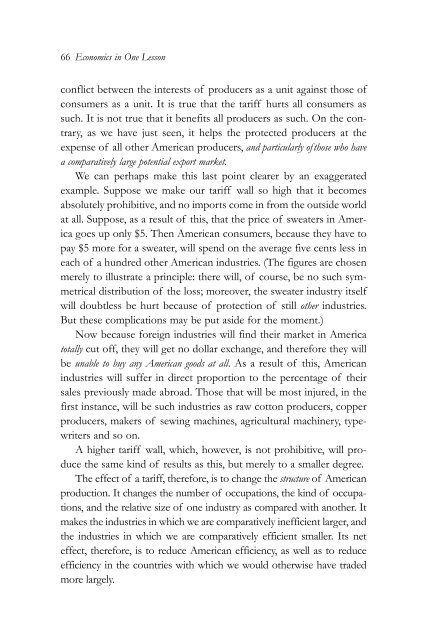1gDdM7w
1gDdM7w
1gDdM7w
- No tags were found...
You also want an ePaper? Increase the reach of your titles
YUMPU automatically turns print PDFs into web optimized ePapers that Google loves.
66 Economics in One Lessonconflict between the interests of producers as a unit against those ofconsumers as a unit. It is true that the tariff hurts all consumers assuch. It is not true that it benefits all producers as such. On the contrary,as we have just seen, it helps the protected producers at theexpense of all other American producers, and particularly ofthose who havea comparatively large potential export market.We can perhaps make this last point clearer by an exaggeratedexample. Suppose we make our tariff wall so high that it becomesabsolutely prohibitive, and no imports come in from the outside worldat all. Suppose, as a result of this, that the price of sweaters in Americagoes up only $5. Then American consumers, because they have topay $5 more for a sweater, will spend on the average five cents less ineach of a hundred other American industries. (The figures are chosenmerely to illustrate a principle: there will, of course, be no such symmetricaldistribution of the loss; moreover, the sweater industry itselfwill doubtless be hurt because of protection of still other industries.But these complications may be put aside for the moment.)Now because foreign industries will find their market in Americatotally cut off, they will get no dollar exchange, and therefore they willbe unable to buy any American goods at all. As a result of this, Americanindustries will suffer in direct proportion to the percentage of theirsales previously made abroad. Those that will be most injured, in thefirst instance, will be such industries as raw cotton producers, copperproducers, makers of sewing machines, agricultural machinery, typewritersand so on.A higher tariff wall, which, however, is not prohibitive, will producethe same kind of results as this, but merely to a smaller degree.The effect of a tariff, therefore, is to change the structure of Americanproduction. It changes the number of occupations, the kind of occupations,and the relative size of one industry as compared with another. Itmakes the industries in which we are comparatively inefficient larger, andthe industries in which we are comparatively efficient smaller. Its neteffect, therefore, is to reduce American efficiency, as well as to reduceefficiency in the countries with which we would otherwise have tradedmore largely.


